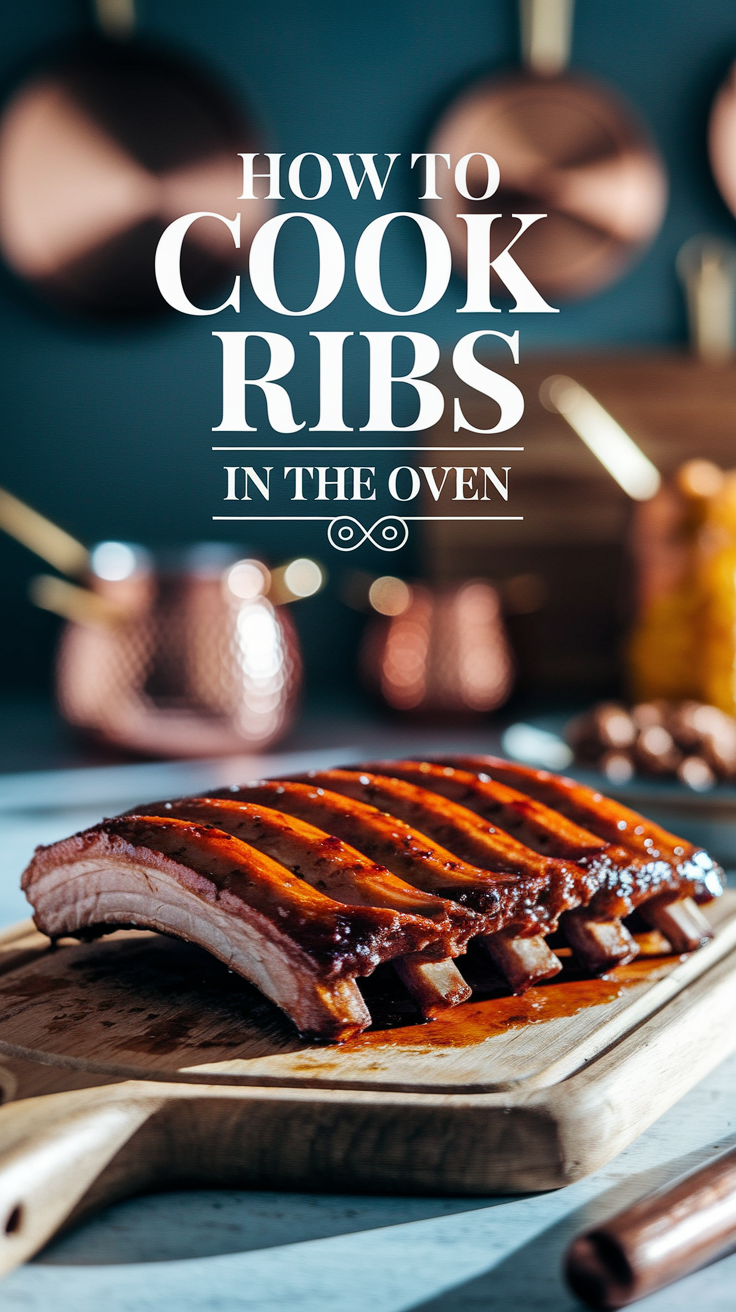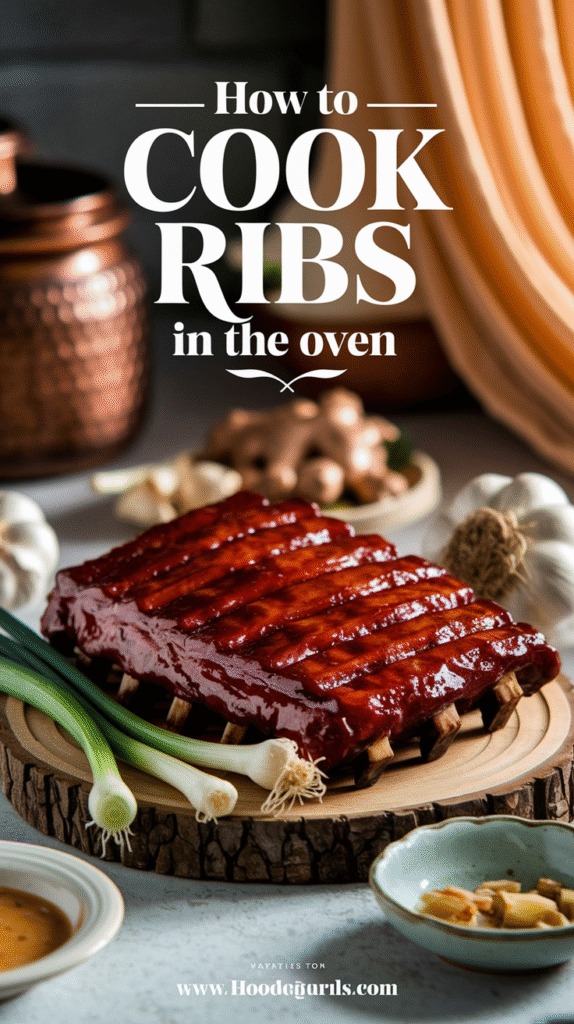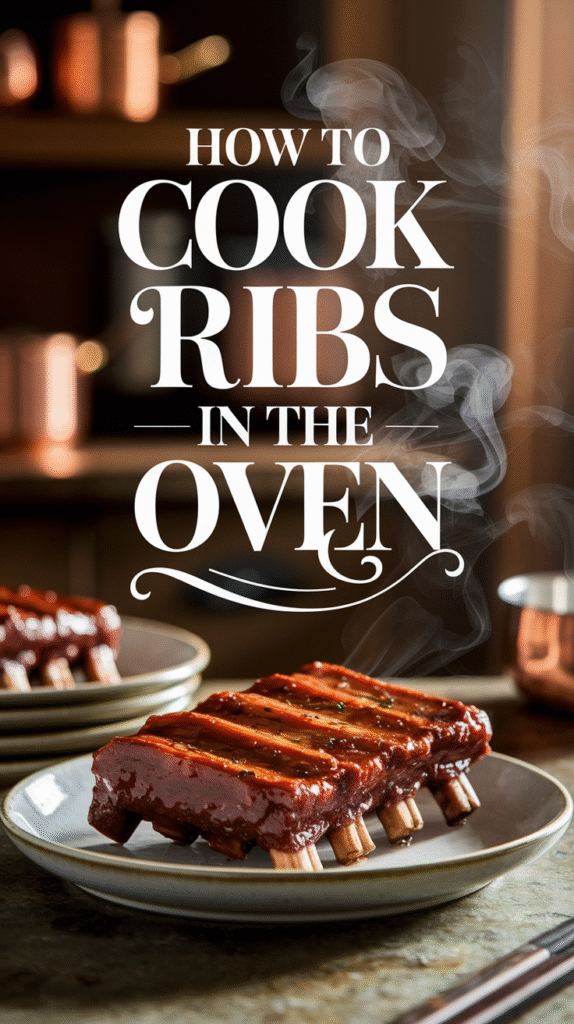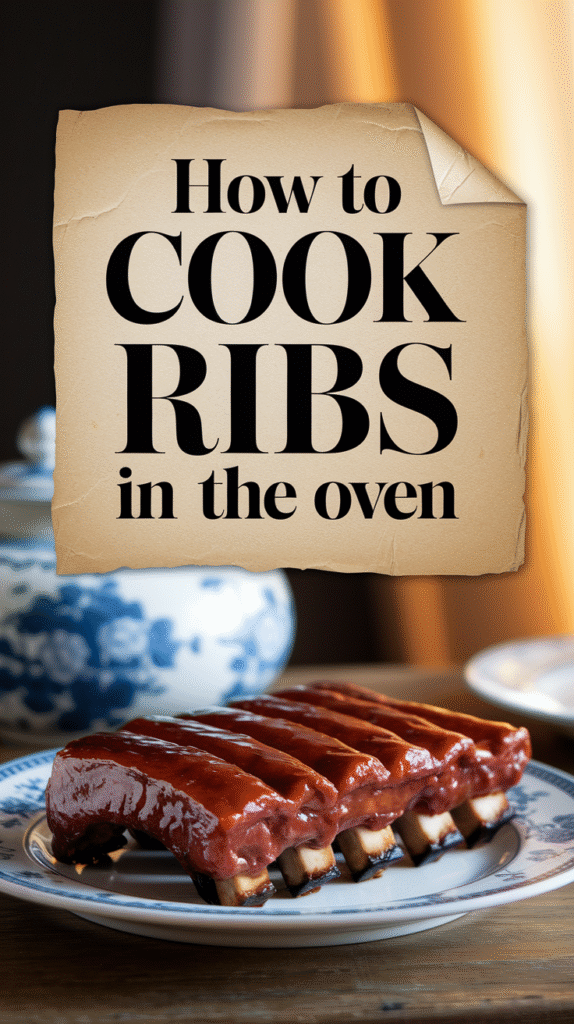Cooking ribs in the oven can be a delightful experience that delivers tender, flavorful results. Whether you’re using pork or beef ribs, mastering some essential techniques can elevate your BBQ game, particularly when outdoor grilling isn’t an option. Let’s explore the steps and tips that will help you cook ribs in the oven like a pro.
Choosing the Right Ribs
When it comes to ribs, the type you select can affect cooking time and flavor. The main varieties are:
- Pork Ribs: Baby back ribs are tender and lean, while spare ribs are meatier and richer in flavor.
- Beef Ribs: These come from the shoulder or back and are known for their robust taste.
Preparing Your Ribs
Before cooking, proper preparation is key to achieving delicious ribs. Here are the steps you should follow:
- Remove the Membrane: Flip the ribs over and locate the thin membrane on the back. Use a butter knife to lift it, then grab it with a paper towel and pull it off. This will allow for better seasoning and tenderness.
- Season Your Ribs: Apply a dry rub or marinade to enhance flavor. Common ingredients for a dry rub include brown sugar, paprika, salt, pepper, and garlic powder. Make sure to coat both sides evenly.
- Resting Time: Allow the seasoned ribs to sit for at least 30 minutes at room temperature. For deeper flavor, refrigerate them overnight.
Cooking Techniques
Once your ribs are prepped, it’s time to cook them. Here are two essential techniques to achieve tender, mouthwatering ribs: low and slow, as well as the foil technique.
Low and Slow Method
This method involves cooking at a lower temperature over an extended period, ideal for tenderness.
Steps:
- Preheat your oven to 275°F (135°C).
- Place the ribs on a baking sheet lined with aluminum foil for easier cleanup.
- Cook the ribs uncovered for about 2.5 to 3 hours, flipping them halfway through.
- Optionally, brush your ribs with BBQ sauce in the last 30 minutes of cooking for a glaze effect.
The Foil Technique
Wrapping the ribs in foil retains moisture and speeds up the cooking process.
Steps:
- Preheat your oven to 300°F (150°C).
- Wrap the seasoned ribs tightly in aluminum foil, sealing all edges to prevent steam from escaping.
- Place the foil-wrapped ribs on a baking sheet and cook for about 2 hours.
- After two hours, unwrap the foil and apply your favorite BBQ sauce.
- Return the ribs to the oven, uncovered, for an additional 30 minutes to allow the sauce to caramelize.
Finishing Touches
Once cooked, you should let the ribs rest for about 10 to 15 minutes before cutting. This allows the juices to redistribute throughout the meat for maximum flavor and tenderness. When ready to serve, slice between the bones to create individual ribs.
Additional Tips
To ensure the best result, consider these extra tips:
- Use a meat thermometer: Ensure that your ribs reach an internal temperature of at least 190°F (88°C) for the best texture.
- Experiment with flavors: Don’t hesitate to try different rubs or marinades. Smoky, sweet, or spicy blends can enhance the flavor profile of your ribs.
- Serve with sides: Ribs pair well with coleslaw, cornbread, or baked beans for a complete meal.
For more tips and recipes on cooking ribs, visit Serious Eats or check out Food Network for a variety of delicious BBQ ideas.
Choosing the Right Cut of Ribs for Oven Cooking
When it comes to cooking ribs in the oven, selecting the right cut is crucial for achieving tender, flavorful results. Different cuts of ribs offer unique textures and flavors, making it essential to know what options are available. Let’s explore the main cuts of ribs you can choose from for your oven cooking adventure.
Types of Ribs
There are several types of ribs, each with distinct characteristics. Here’s a quick breakdown:
- Baby Back Ribs: These are smaller, leaner ribs that come from the top part of the pig’s ribcage. They are tender and have a sweet flavor, making them a popular choice for many.
- Spare Ribs: Spare ribs are larger and meatier, coming from the belly of the pig. They have a richer flavor due to their higher fat content and are often cooked longer to make them tender.
- St. Louis Style Ribs: A subset of spare ribs, St. Louis style ribs are trimmed to have a rectangular shape, removing the rib tips. This cut has an excellent balance of meat and fat, which makes it great for oven cooking.
- Country-Style Ribs: These aren’t technically ribs but rather cuts from the shoulder. They are meatier and require different cooking techniques but can be delicious when properly cooked.
Factors to Consider When Choosing Ribs
Choosing the right cut of ribs for your cooking style is not just about preference; it’s also about how much time you’re willing to invest. Here are some factors to consider:
| Type of Rib | Tenderness | Flavor | Cooking Time |
|---|---|---|---|
| Baby Back Ribs | Tender | Sweet | 2.5 – 3 hours |
| Spare Ribs | Meaty | Rich | 3 – 4 hours |
| St. Louis Style Ribs | Meaty | Balanced | 3 – 4 hours |
| Country-Style Ribs | Very Tender | Rich | 2 – 3 hours |
Why Choose Baby Back Ribs?
Baby back ribs are fantastic for those who enjoy a mild flavor and tender meat. Since they require a shorter cooking time, they are ideal if you’re looking for something quick and satisfying. Season them simply with salt and pepper or elevate the taste with your favorite barbeque sauce.
Why Choose Spare Ribs?
If you’re in the mood for it, spare ribs offer a more robust flavor. Because they contain more fat, they can be more forgiving during the cooking process. As long as you give them enough time to cook down, they will be flavor-packed and tender. Pair spare ribs with a tangy sauce for an explosion of taste.
Why Choose St. Louis Style Ribs?
St. Louis style ribs are great for those who want a combination of both the tenderness of baby back ribs and the meatiness of spare ribs. Their meticulous trimming means less preparation time for you. They hold sauces well and are perfect for oven cooking, ensuring an evenly cooked rack.
Why Choose Country-Style Ribs?
If you prefer more meat and less bone, country-style ribs are an excellent choice. They are easily adaptable to various cooking methods, including baking in the oven. Their rich flavor profile means you can cook them with just about any marinade or rub and still achieve delicious results.
Ultimately, the best cut of ribs for oven cooking depends on your preferences, cooking style, and available time. Whichever type of ribs you choose, ensure to season generously and allow ample cooking time for the best flavor and tenderness.
For more tips and recipes, visit Food Network or check out Serious Eats, which offer wonderful insights into cooking ribs.
Flavor Enhancements: Marinades and Rubs for Oven-Cooked Ribs
Cooking ribs in the oven can yield delicious results when paired with the right marinades and rubs. Utilizing these flavor enhancements enhances the taste of the meat and can turn a simple family dinner into a mouth-watering feast. Here’s how you can elevate your oven-cooked ribs with some easy and effective marinades and rubs.
Understanding Marinades
Marinades are mixtures that typically include an acid, oil, and spices. They serve to tenderize and infuse flavors into your ribs. The acid in marinades, such as vinegar or citrus juice, breaks down proteins, making the meat more tender. Here’s a quick guide on how to create a basic marinade:
- Base: Use 1 part acid (like apple cider vinegar or lemon juice) to 3 parts oil (such as olive oil).
- Flavorings: Add herbs, spices, garlic, or onion for more flavor.
- Sweetener: Consider adding a bit of honey or brown sugar for a hint of sweetness.
Left to marinate for a few hours or overnight, this blend can work wonders on your ribs. Remember to place the ribs in a resealable bag or a non-metal container, ensuring they are coated evenly. Seal the bag and let the marinade work its magic in the refrigerator.
Popular Marinade Recipes
Here are a couple of recipes to inspire you:
| Marinade Name | Ingredients | Marinating Time |
|---|---|---|
| BBQ Sweet Marinade | 1 cup BBQ sauce, 1/4 cup apple cider vinegar, 2 tablespoons honey | 4-6 hours |
| Spicy Garlic Marinade | 1/4 cup soy sauce, 1/4 cup olive oil, 1 tablespoon minced garlic, 1 teaspoon red pepper flakes | 2-4 hours |
Exploring Rubs
Rubs are a mix of dry spices and herbs that create a crust on the ribs as they cook. Unlike marinades, rubs do not require time to soak in moisture, making them a quicker flavor option. A well-made rub can enhance the natural flavors of the meat and add depth. A basic rib rub typically includes:
- Brown Sugar: For sweetness and caramelization.
- Paprika: Adds color and a mild spice.
- Garlic Powder: For savory flavor.
- Salt and Pepper: Essential for seasoning.
- Cayenne Pepper: For a touch of heat.
Combine equal parts of the above ingredients in a bowl and mix well. Generously rub this blend over the ribs before cooking. Allow the rub to sit for at least 30 minutes to an hour before placing the ribs in the oven.
Popular Rub Recipes
Here are some easy rubs to try:
| Rub Name | Ingredients |
|---|---|
| Classic BBQ Rub | 1/2 cup brown sugar, 1/4 cup paprika, 2 tablespoons chili powder, 1 tablespoon black pepper, 1 tablespoon salt |
| Herb-Spice Rub | 1/4 cup rosemary, 1/4 cup thyme, 1 tablespoon garlic powder, 1 tablespoon onion powder, 1 tablespoon olive oil |
Cooking Your Ribs
After marinating or applying your rub, preheat your oven to 300°F (150°C). Place the ribs on a baking sheet lined with foil to make cleanup easier. Bake for about 2.5 to 3 hours, wrapped in foil to keep them moist. Finish them off under the broiler for a few minutes at the end to get a nice char and enhance those flavors.
For more tips on cooking ribs and exploring other grilling techniques, visit Food Network’s Rib Recipes or Serious Eats for detailed guides.
By experimenting with different marinades and rubs, you can customize your oven-cooked ribs to suit your taste preference. Whether you like it sweet, spicy, or savory, the right blend of flavors can enhance every bite.
Step-by-Step Guide to Perfectly Baking Ribs
Baking ribs in the oven can yield delicious, tender, and juicy results. With the right techniques, you can enjoy fall-off-the-bone ribs that’ll impress your family and friends. Follow this step-by-step guide to create perfectly baked ribs that burst with flavor and moisture.
Choosing the Right Ribs
When selecting ribs, there are a few options to consider:
- Baby Back Ribs: These ribs are shorter and leaner with a mild flavor, perfect for quick cooking.
- Spare Ribs: Larger and fattier than baby back ribs, these offer a robust flavor and require longer cooking times.
- St. Louis Style Ribs: A cut from spare ribs, these are trimmed into a rectangular shape, providing a uniform cooking surface.
Choose according to your taste preference and the time you have for cooking.
Ingredients You Will Need
Ensure you have the following ingredients ready:
- Ribs (your choice: baby back, spare, or St. Louis)
- Your favorite dry rub or marinade
- Barbecue sauce (optional, for glazing)
- Aluminum foil
- A baking dish or sheet
Preparing the Ribs
Start by preparing your ribs for cooking. Here’s how:
- Remove the Membrane: Flip the ribs so the bone side is up. Use a knife to lift one corner of the tough membrane covering the bones. Grab it with a paper towel and pull it off completely for more tender ribs.
- Apply the Dry Rub: Sprinkle your dry rub generously over both sides of the ribs. Rub it in well to enhance the flavor. If using a marinade, let the ribs soak for at least an hour, or overnight for maximum flavor.
Baking the Ribs
Now that your ribs are prepped, it’s time to bake them in the oven:
- Preheat Your Oven: Set your oven to 300°F (150°C). This low and slow cooking method will ensure juicy ribs.
- Wrap the Ribs: Place the ribs on a baking sheet. Cover them tightly with aluminum foil. This will trap moisture, keeping the ribs tender during cooking.
- Bake Them: Put the covered ribs in the preheated oven. Bake for approximately 2.5 to 3 hours. Check for tenderness; the meat should start pulling away from the bones.
Finishing Touches
For that perfect glaze, follow these steps after the ribs are tender:
- Brush with Barbecue Sauce: Remove the ribs from the oven and carefully unwrap the foil. Brush a layer of barbecue sauce over the top.
- Broil for Crispy Edges: Set your oven to broil. Place the ribs back in the oven under the broiler for about 5-10 minutes, watching closely to prevent burning.
Serving Suggestions
Let the ribs rest for a few minutes after broiling, then cut between the bones to serve. Pair them with coleslaw, baked beans, or cornbread for a perfect barbecue feast. Don’t forget extra barbecue sauce on the side!
Additional Tips for Perfect Ribs
- Experiment with different rubs and marinades to find your favorite flavor.
- Try wrapping the ribs with brown sugar or honey for added sweetness before baking.
- Adjust the baking time depending on the thickness of the ribs.
If you’re a barbecue enthusiast, you might find further techniques and recipes on Serious Eats or enhance your skills with insights from Bon Appétit.
Now that you have this guide, get cooking, and enjoy the delightful experience of perfectly baked ribs right from your oven!
Common Mistakes to Avoid When Cooking Ribs in the Oven
Cooking ribs in the oven can be a delightful culinary experience, but there are several common mistakes that can impact the final result. Avoiding these pitfalls ensures tender, flavorful, and succulent ribs that can rival any barbecue in the backyard. Here’s what you need to keep in mind as you prepare to cook your ribs in the oven.
1. Not Removing the Membrane
One of the most overlooked aspects of preparing ribs is the membrane. This thin layer found on the bone side of the ribs can become tough and chewy when cooked. It’s important to remove this membrane before seasoning, allowing your flavors to penetrate better during cooking.
2. Skipping the Seasoning
Seasoning your ribs is crucial for building flavor. Simply rubbing the ribs with salt and pepper might not be enough. Consider using a dry rub made from various spices such as paprika, garlic powder, onion powder, and a touch of brown sugar. A well-seasoned rib will have a delightful crust that adds depth to the taste.
3. Cooking at Too High a Temperature
Many people think that cooking ribs at a high temperature will yield quicker results. While it might speed up the cooking process, it often results in dry, tough meat. For juicy and tender ribs, aim for a low and slow approach. Cooking them at around 275°F allows the connective tissue to break down, resulting in tender ribs.
4. Ignoring the Cooking Time
Cooking ribs in the oven isn’t an exact science, and the cooking time can vary based on several factors, including the thickness of the ribs and your oven’s calibration. On average, spare ribs will need about 2.5 to 3 hours while baby back ribs usually require about 2 to 2.5 hours. Always check for doneness before removing them from the oven.
5. Not Using Foil
Cooking ribs covered with foil can help to steam and retain moisture. Wrapping them tightly creates a mini-oven effect, allowing the ribs to cook evenly. After the first couple of hours, you can remove the foil and brush on sauce for the last 30 minutes for that nice sticky glaze.
6. Overbasting with Sauce
It’s tempting to slather ribs in sauce at the beginning of cooking, but overbasting can lead to burnt sauce and a less than desirable taste. Instead, apply the sauce during the last 30 minutes to an hour of cooking. This way, the sauce caramelizes without burning, enhancing the flavor profile of the ribs.
7. Not Letting the Ribs Rest
Once your ribs have finished cooking, letting them rest for at least 10-15 minutes is crucial. This resting period allows the juices to redistribute, ensuring that each bite is juicy and full of flavor. Cutting into the ribs too soon can lead to a loss of moisture and flavor.
8. Using the Wrong Ribs
Different types of ribs require different cooking methods and times. If you’re using baby back ribs, follow the guidelines for those specific cuts, as they tend to cook faster than spare ribs. Knowing which type of rib you’re working with is essential for successful results.
9. Not Monitoring Internal Temperature
A meat thermometer can be your best friend in cooking ribs. A safe internal temperature for pork ribs is about 190°F to 203°F. At this stage, the connective tissue has broken down, making the ribs tender without being overdone.
10. Failing to Experiment with Flavors
Cooking is an art, and ribs provide a canvas for creativity. Don’t hesitate to play around with different spice blends, marinades, or sauces. You might discover unique flavor combinations that suit your palate. Exploring flavor profiles can elevate your ribs to a whole new level. For more recipes and tips, check out Food Network or Epicurious.
Cooking ribs in the oven can yield incredible results when you avoid these common mistakes. The key is to be patient, season well, and pay attention to cooking times. By doing so, you’ll enjoy perfectly cooked, mouthwatering ribs that will impress your friends and family. Happy cooking!
Conclusion
Successfully cooking ribs in the oven opens the door to delicious and tender meals that everyone can enjoy. By mastering essential techniques, you can achieve that mouthwatering texture and flavor you’re after. Selecting the right cut of ribs, whether baby back, spare ribs, or St. Louis style, is key to perfecting your dish. They each require different cooking times and methods, so knowing your options plays a crucial role in the outcome.
Flavor is vital when it comes to ribs, and this is where marinades and dry rubs make a significant impact. From sweet and smoky to spicy and tangy, the right seasoning can elevate your dish. Remember, a well-prepared marinade not only enhances the flavor but also tenderizes the meat, making each bite a delight.
Following a step-by-step guide ensures that you don’t miss any crucial elements for baking ribs perfectly. Keeping the oven at the right temperature, monitoring cooking time, and allowing for rest after baking are all part of achieving success. It’s also important to be aware of common mistakes, like undercooking or overcooking, which can detract from your efforts.
With the knowledge gained here, you now have the tools needed to become a master rib cook. Whether it’s for a family dinner or a special gathering, cooking ribs in the oven can be an enjoyable and rewarding experience. So gather your ingredients, set your oven, and get ready to impress with your flavorful and tender oven-cooked ribs!







Leave a Reply